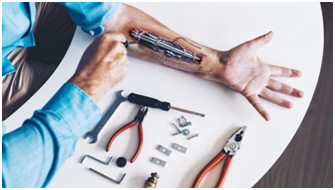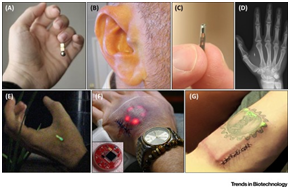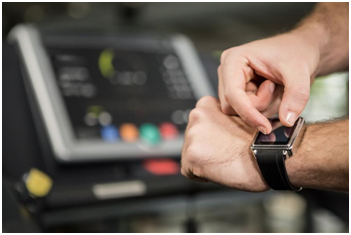Cyber Security Assignment Exploring Bio-Hacking Techniques
Question
Task: Prepare a detailed and well-researched assignment discussing the bio-hacking techniques.
Answer
Introduction
Bio-hacking is a part of technology which is mainly used for scanning and performing science experiments on human body systems. In this generation, health and medical communities are moving towards the digital technologies where bio-hacking is leading example that enables them to improve the health and wellbeing of the individuals. With the help of bio-hacking processes and techniques, individuals can lose their weight in less time by enhancing brain functions effectively. The purpose of this report is to find effective information and points related to the bio-hacking techniques and enhance overall understanding. This research will cover various chapters for example description of bio-hacking, history of bio-hacking, types of bio-hacking and its implications. Moreover, viewpoints of other writers and examples related to bio-hacking will be included so that effectiveness of the research can be improved.
Bio-hacking and its description
The term bio-hacking is defined as a biological experiment which is mainly applied to the human body in order to enhance the qualities of living organisms especially by groups working outside a conventional medical atmosphere. Bio-hacking techniques include RFID chips, sensors, magnets and other technological implants under the human body so that scanning and evaluation of skin and parts can be done effectively. Gangadharbatla, (2020) reported that bio-hacking is capable to optimize human body systems using biological programs and technologies so that appropriate solutions can be delivered to the patients. Biohacking is an extremely expansive idea.

Figure: bio-hacking
(Source: Gangadharbatla, 2020)
It goes from individuals that drink impenetrable espresso or individuals that have chips embedded in their body, to individuals that utilization at-home DNA examination unit. Biohackers regularly partner themselves with biopunk, transhumanism or techno-reformism (Zettler, Guerrini, and Sherkow, 2020).
Some biohackers are generally centred on improving their presentation, regardless of whether it is actually or at work. Self-improvement is the latest bio-hacking trend where bio-hackers guides and provide proper information to the patients so that level of health and well-being can be improved. In this modern era, bio-hacking techniques are shifting medical and healthcare communities towards technological systems and depending on the sensors and computer systems where machines and networks are working on the health concerns of the patients.
There are few other trends based on the bio-hacking techniques in the field of medicine for example microchip implants among patients, creepy sci-fi vibes and DNA injections. The major consequence of using bio-hacking is that it is completely depended on the sensors and technologies where improper connections and interaction can impact on the entire body and also provide insufficient results. Ibarra, Jahankhani, and Beavers, (2020) agreed and reported that the uses of bio-hacking technologies require proper communication and integration systems where it is important for medical groups to manage technical errors so that proper results can be obtained. Notwithstanding its modern standpoint and results, biohacking stays a generally solo, risky if not illicit development. Despite the fact that the exploration and results delivered by biohackers are weighty, it likewise breaks a few moral codes on human experimentation and imperilling live of a few people.
Proficient labs pursue a point by point security cycle to guarantee that researchers and their ideas are in a restricted and appropriate climate. Network labs, generally work out of carports, and cannot be protected from risks and mishaps that have the capability of delivering various obscure strands of bacterial contamination affecting a huge populace around. Medical and healthcare labs could likewise be ideal focuses for bioterrorists for building up a perilous mixed drink of bio-weapons. Privacy is a major concern linked with the bio-hacking where communication channels and sensors are linked with the human body that can be hacked by the attackers easily (Meyer, and Vergnaud, 2020).

Figure: Bio-hacking trends
(Source: Meyer, and Vergnaud, 2020)
Security is a serious concern linked with the bio-hacking based chips implanted in the bodies due to which private data and daily life activities can be hacked by the criminals. All these are major consequences of using bio-hacking technologies for which proper plans and security programs should be implemented.
Uses of bio-hacking
It is found that bio-hacking is now adopted in the medical groups in order to deliver appropriate healthcare services to the patients by implanting chips among body systems. With the help of bio-hacking chips optimization of the human body can be done in a significant manner. Kolesnik, et al., (2018) reported that bio-hacking enable medical sectors to move towards digital innovation and perform operations using chips and sensors. Self-tracking is another application of bio-hacking that helps healthcare systems to track and integrate the location and performance of body systems so that reliable healthcare programs can be applied to the patients.
History of bio-hacking
Bio-hacking is also called as “do-it-yourself biology” that was described in 1988. Bio-hacking has entered the San Francisco developer communities in 2005. In the year 2008, the DIYbio community was developed by Jason and described bio-hacking as a process of optimizing human body systems. In the year 2014, more than 50 bio-hacking labs have been implemented around the world in order to deliver proper care and bio-technological facilities to the patients and maintain the level of accountability. In the year 2016, the first conference about bio-hacking was proposed for reviewing and providing information related to bio-hacking uses to the individuals. In this era, most of the medical and healthcare communities are using bio-hacking programs and systems for handling healthcare problems faced by the patients.
Types of bio-hacking
There are various types of bio-hacking techniques used which are described below:
Nutrigenomics
It is determined that nutrigenomics mainly focuses on how food individuals eat interacts with their genes and organs. It is one of the popular types of bio-hacking which is capable to review and maintain the level of well-being by addressing problems from human body systems. It isexamined that nutrigenomics is capable to examine how various nutrients impact on the behavior, feelings and body of the individuals. In the field of weight loss, nutrigenomics bio-hacking is used that allows reviewing dietary plans and delivers significant nutrients.
DIY biology
It is another type of bio-hacking technique spearheaded by individuals with training and experience in the field of medical science. These biohackers provide tips and procedures to support non-specialists direct organized tests on themselves outside of a controlled trial climate, similar to labs or clinical workplaces.
Grinder
It is a biohacking subculture that sees all aspects of the human body as hack-capable. By and large, processors try to become "cyborgs" by advancing their bodies with a mix of devices, compound infusions, inserts, and whatever else they can place into their body to make it work the manner in which they need it to. Therefore, all these are major types of bio-hacking used in the field of medical science.
Impact of bio-hacking
Bio-hacking is now an important part of the medical science that helps to optimize and integrate body parts using sensors and computing systems so that problems and health issues can be identified easily. It is capable to positively impact on the healthcare and medical fields where appropriate solutions can be delivered to the patients and medical groups can move towards the digital technologies and innovations. 3D body printing is a leading example of bio-hacking technique where scanning process can be done using scanner and sensors and 3D images can be obtained in a significant manner (Yetisen, 2018). However, bio-hacking is depended on the computer networks and communication channels where miss-configuration and security risks can lead the chances of data breach and cyber-attacks. Electronic chips are implanted in the human body where it is easy for the criminals to send frauds and reduce the security of chips by which ethical issues can be produced.
For example, in the year 2015, an American army persona examined the implications of a microchip implanted in his body system. The chip was imperceptible by the military scanners and chip was included for the communication purpose. The chip permitted the client to hack into and control any phone in its region. In 2015 itself, another chip was presented at the Security Analyst Conclave in Cancun. It was tracker embed, which could likewise be utilized to create passwords and maintain communication. However, the hackers targeted these chips and computer servers for gaining accessibility of data and collected daily life activities of an army man. Therefore, it is reported that security should be improved while using bio-hacking chips so that personal data and programs can be secured in a reliable manner.

Figure: bio-hacking security
(Source: Yetisen, 2018)
Weight loss is another leading example of bio-hacking that allows the patients to focus on the proper dietary plans and lifestyle chances in order to make enhancement in health and fitness.

Figure: bio-hacking for weight loss
(Source: Kolesnik, et al., (2018)
It is found that bio-hackers allow the patients for quickly losing weight in order to enhance brain functions. In the future generation, healthcare and medical communities will be depended on the bio-hacking systems and technologies.
Conclusion
From this research, it may be concluded that bio-hacking is more helpful and appropriate for medical science by which integration and optimization of the human body can be done easily. This report provided a way to enhance knowledge in regards to the bio-hacking and its implications on the human body. It is found that bio-hacking uses sensors and chips where it is difficult to manage security threats and risks shared by the hackers due to which personal data and accessibility can be gained by the criminals easily. It is proficient to decidedly effect on the medical care and clinical fields where fitting arrangements can be conveyed to the patients and clinical gatherings can move towards the computerized advancements and developments. 3D body printing is the main illustration of the bio-hacking method where checking cycle should be possible utilizing scanner and sensors and 3D pictures can be acquired in a critical way. Nonetheless, bio-hacking has relied upon the PC organizations and correspondence channels where miss-setup and security dangers can lead the odds of information break and digital assaults. So, it is suggested that security controls and measures should be linked with the bio-hacking chips and sensors.
References
Gangadharbatla, H., (2020) Biohacking: An exploratory study to understand the factors influencing the adoption of embedded technologies within the human body. Heliyon, 6(5), p.e03931.
Ibarra, J., Jahankhani, H. and Beavers, J., (2020) Biohacking Capabilities and Threat/Attack Vectors. In Cyber Defence in the Age of AI, Smart Societies and Augmented Humanity, 6(2), pp. 117-131.
Kolesnik, Y.N., Yurina, N.A., Yurin, D.A., Danilova, A.A., Korotky, V.P., Ryzhov, V.A. and Zenkin, A.S., (2018) Development of biohacking elements drawn from the example of cows under stress conditions. International Journal of Pharmaceutical Research, 10(4).
Meyer, M. and Vergnaud, F., (2020) The rise of biohacking: Tracing the emergence and evolution of DIY biology through online discussions. Technological Forecasting and Social Change, 160, p.120206.
Yetisen, A.K., (2018) Biohacking. Trends in Biotechnology, 36(8), pp.744-747.
Zettler, P.J., Guerrini, C.J. and Sherkow, J.S., (2019) Regulating genetic biohacking. Science, 365(6448), pp.34-36.












